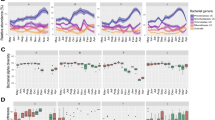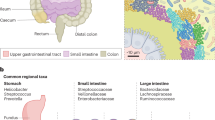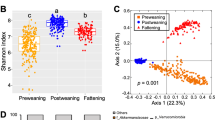Abstract
To explain differences in gut microbial communities we must determine how processes regulating microbial community assembly (colonization, persistence) differ among hosts and affect microbiota composition. We surveyed the gut microbiota of threespine stickleback (Gasterosteus aculeatus) from 10 geographically clustered populations and sequenced environmental samples to track potential colonizing microbes and quantify the effects of host environment and genotype. Gut microbiota composition and diversity varied among populations. These among-population differences were associated with multiple covarying ecological variables: habitat type (lake, stream, estuary), lake geomorphology and food- (but not water-) associated microbiota. Fish genotype also covaried with gut microbiota composition; more genetically divergent populations exhibited more divergent gut microbiota. Our results suggest that population level differences in stickleback gut microbiota may depend more on internal sorting processes (host genotype) than on colonization processes (transient environmental effects).
Similar content being viewed by others
Log in or create a free account to read this content
Gain free access to this article, as well as selected content from this journal and more on nature.com
or
References
Atarashi K, Tanoue T, Oshima K, Suda W, Nagano Y, Nishikawa H et al. (2013). Treg induction by a rationally selected mixture of Clostridia strains from the human microbiota. Nature 500: 232–236.
Benson AK, Kelly SA, Legge R, Ma F, Low SJ, Kim J et al. (2010). Individuality in gut microbiota composition is a complex polygenic trait shaped by multiple environmental and host genetic factors. Proc Natl Acad Sci USA 107: 18933–18938.
Bergh Ø . (1995). Bacteria associated with early life stages of halibut, Hippoglossus hippoglossus L., inhibit growth of a pathogenic Vibrio sp. J Fish Dis 18: 31–40.
Biswas A, Kobayashi KS . (2013). Regulation of intestinal microbiota by the NLR protein family. Int Immunol 25: 207–214.
Bokulich NA, Subramanian S, Faith JJ, Gevers D, Gordon JI, Knight R et al. (2013). Quality-filtering vastly improves diversity estimates from Illumina amplicon sequencing. Nat Method 10: 57–59.
Bolnick DI . (2011). Sympatric speciation in threespine stickleback: why not? Int J Ecol 2011: 1–15.
Bolnick D, Snowberg LK, Caporaso JG, Lauber CL, Knight R, Stutz WE . (2014a). Major Histocompatibility Complex class IIB polymorphism influences gut microbiota composition and diversity. Mol Ecol 23: 4831–4845.
Bolnick DI, Snowberg LK, Hirsch PE, Lauber PE, Knight R, Caporaso JG et al. (2014b). Individuals’ diet diversity influences gut microbial diversity in two freshwater fish (threespine stickleback and Eurasian perch). Ecol Lett 17: 979–987.
Bolnick DI, Snowberg LK, Hirsch PE, Lauber CL, Org E, Parks B et al. (2014c). Individual diet has sex-dependent effects on gut vertebrate gut microbiota. Nat Commun 5: 4500.
Caldera EJ, Bolnick DI . (2008). Effects of colonization history and landscape structure on genetic variation within and among lacustrine populations of threespine sticklebacks in a watershed. Evol Ecol Res 10: 1–24.
Campbell AC, Buswell JA . (1983). The intestinal microflora of farmed Dover sole (Solea solea) at different stages of fish development. J Appl Bacteriol 55: 215–223.
Caporaso JG, Kuczynski J, Stombaugh J, Bittinger K, Bushman FD, Costello EK et al. (2010). QIIME allows analysis of high-throughput community sequencing data. Nat Methods 7: 335–336.
Caporaso JG, Lauber CL, Walters WA, Berg-Lyons D, Lozupone CA, Turnbaugh PJ et al. (2011). Global patterns of 16S rRNA diversity at a depth of millions of sequences per sample. Proc Natl Acad Sci USA 108: 4516–4522.
Carlisle EM, Poroyko V, Caplan MS, Alverdy JA, Liu D . (2011). Gram negative bacteria are associated with the early stages of necrotizing enterocolitis. PLoS One 6: e18084.
Carvaho FA, Aitken JD, Vijay-Kumar M, Gewirtz AT . (2012). Toll-like receptor-gut microbiota interactions: perturb at your own risk!. Annu Rev Physiol 74: 177–198.
Cebula A, Seweryn M, Rempala GA, Pabla SS, McIndoe RA, Denning TL et al. (2013). Thymus-derived regulatory T cells contribute to tolerance to commensal microbiota. Nature 497: 258–262.
Costello EK, Stagaman K, Dethlefsen L, Bohannan BJM, Relman DA . (2012). The application of ecological theory toward an understanding of the human microbiome. Science 336: 1255–1262.
Dethlefsen L, Eckburg PB, Bik EM, Relman DA . (2006). Assembly of the human intestinal microbiota. Trends Ecol Evol 21: 517–523.
DeSantis TZ, Hugenholtz P, Larsen N, Rojas M, Brodie EL, Keller K et al. (2006). Greengenes, a chimera-checked 16S rRNA gene database and workbench compatible with ARB. Appl Environ Microbiol 72: 5069–5072.
Dominguez-Bello MG, Costello EK, Contreras M, Magris M, Hidalgo G, Fierer N et al. (2010). Delivery mode shapes the acquisition and structure of the initial microbiota across multiple body habitats in newborns. Proc Natl Acad Sci USA 107: 11971–11975.
Eizaguirre C, Lenz TL . (2010). Major histocompatibility complex polymorphism: dynamics and consequences of parasite-mediated local adaptation in fishes. J Fish Biol 77: 2023–2047.
Faith JJ, McNulty NP, Rey FE, Gordon JI . (2011). Predicting a human gut microbiota's response to diet in gnotobiotic mice. Science 333: 101–104.
Frazier TH, DiBaise JK, McClain CJ . (2011). Gut microbiota, intestinal permeability, obesity-induced inflammation, and liver injury. JPEN J Parenter Enteral Nutr 35(5 Suppl 14S–20S.
Gomez GD, Balcazar JL . (2008). A review on the interactions between gut microbiota and innate immunity of fish. FEMS Immunol Med Microbiol 52: 145–154.
Hagen DW, McPhail JD . (1970). The species problem within Gasterosteus aculeatus on the Pacific coast of North America. J Fisheries Board Can 27: 147–155.
Hansen GH, Olafsen JA . (1999). Bacterial interactions in early life stages of marine cold water fish. Microb Ecol 38: 1–26.
Haiser HJ, Turnbaugh PJ . (2012). Is it time for a metagenomic basis of theraputics? Science 336: 1253–1255.
Hendry AP, Bolnick DI, Berner D, Peichel CL . (2009). Along the speciation continuum in sticklebacks. J Fish Biol 8: 2000–2036.
Hendry AP, Kaeuffer R, Crispo E, Peichel CL, Bolnick DI . (2013). Evolutionary inferences from the analysis of exchangeability. Evolution 67: 3429–3441.
Hildebrandt MA, Hoffmann C, Sherrill–Mix SA, Keilbaugh SA, Hamady M, Chen YY et al. (2009). High-fat diet determines the composition of the murine gut microbiome independently of obesity. Gastroenterology 137: 1716–1724.
Hofer U, Speck RF . (2009). Disturbance of the gut-associated lymphoid tissue is associated with disease progression in chronic HIV infection. Semin Immunopathol 31: 257–266.
Hooper LV, Littman DR, Macpherson AJ . (2012). Interactions between the microbiota and the immune system. Science 336: 1268–1273.
Jones FC, Grabherr MG, Chan YF, Russell P, Mauceli E, Johnson J et al. (2012). The genomic basis of adaptive evolution in threespine sticklebacks. Nature 484: 55–61.
Kovacs A, Ben-Jacob N, Tayem H, Halperin E, Iraqi FA, Gophna U . (2011). Genotype is a stronger determinant than sex of the mouse gut microbiota. Microb Ecol 61: 423–428.
Knights D, Costello EK, Knight R . (2011). Supervised classification of human microbiota. FEMS Microbiol Rev 35: 343–359.
Laparra JM, Sanz Y . (2010). Interactions of gut microbiota with functional food components and nutraceuticals. Pharmacol Res 61: 219–225.
Lavin PA, McPhail JD . (1985). The evolution of freshwater diversity in the threespine stickleback (Gasterosteus aculeatus): site-specific differentiation of trophic morphology. Can J Zool 83: 2632–2638.
Leão PN, Ramos V, Vale M, Machado JP, Vasconcelos VM . (2012). Microbial community changes elicited by exposure to cyanobacterial allelochemicals. Microb Ecol 63: 85–95.
Levins R . (1970). Extinction. Lecture Note Math 2: 75–107.
Ley RE, Lozupone CA, Hamady M, Knight R, Gordon JI . (2008). Worlds within worlds: evolution of the vertebrate gut microbiota. Nat Rev Microbiol 6: 776–788.
Liston J . (1956). Quantitative variations in the bacterial flora of flatfish. J Gen Microbiol 15: 305–314.
Lozupone C, Faust K, Raes J, Faith JJ, Frank DN, Zaneveld J et al. (2012). Identifying genomic and metabolic features that can underlie early successional and opportunistic lifestyles of human gut symbionts. Genome Res 22: 1974–1984.
Lozupone CA, Knight R . (2005). UniFrac: a new phylogenetic method for comparing microbial communities. Appl Environ Microbiol 71: 8228–8235.
Lozupone CA, Knight R . (2007). Global patterns in bacterial diversity. Proc Natl Acad Sci USA 104: 11436–11440.
Mahowald MA, Rey FE, Seedorf H, Turnbaugh PJ, Fulton RS, Wollam A et al. (2009). Characterizing a model human gut microbiota composed of members of its two dominant bacterial phyla. Proc Natl Acad Sci USA 106: 5859–5864.
Maslowski KM, Mackay CR . (2011). Diet, gut microbiota and immune responses. Nat Immunol 12: 5–9.
Matthews B, Marchinko KB, Bolnick DI, Mazumder A . (2010). Specialization of trophic position and habitat use by sticklebacks in an adaptive radiation. Ecology 91: 1025–1034.
Meadow JF, Bateman AC, Herkert KM, O’Connor TK, Green JL . (2013). Significant changes in the skin microbiome mediated by the sport of roller derby. PeerJ 1: e53.
Muegge BD, Kuczynski J, Knights D, Clemente JC, Gonzalez A, Fontana L et al. (2011). Diet drives convergence in gut microbiome functions across mammalian phylogeny and within humans. Science 332: 970–974.
Nicholson JK, Holmes E, Kinross J, Burcelin R, Gibson GR, Wei J et al. (2012). Host-gut microbiota metabolic interactions. Science 336: 1262–1267.
O'Dwyer JP, Kembel SW, Green JL . (2012). Phylogenetic diversity theory sheds light on the structure of microbial communities. PLoS Comput Biol 8: e1002832.
Pantoja-Feliciano IG, Clemente JC, Costello EK, Perez ME, Blaser MJ, Knight R et al. (2013). Biphasic assembly of the murine intestinal microbiota during early development. ISME J 7: 1112–1115.
Parks JM, Johs A, Podar M, Bridou R, Hurt RA, Smith SD et al. (2013). The genetic basis for bacterial mercury methylation. Science 339: 1332–1335.
R Development Core Team. (2012) R: A language and environment for statistical computing. R Foundation for Statistical Computing: Vienna, Austria, ISBN 3-900051-07-0, URL http://www.R-project.org/.
Reusch TB, Wegner KM, Kalbe M . (2001). Rapid genetic divergence in postglacial populations of threespine stickleback (Gasterosteus aculeatus): the role of habitat type, drainage and geographical proximity. Mol Ecol 10: 2435–2445.
Rey FE, Faith JJ, Bain J, Muehlbauer MJ, Stevens RD, Newgard CB et al. (2010). Dissecting the in vivo metabolic potential of two human gut acetogens. J Biol Chem 285: 22082–22090.
Robertson SJ, Girardin SE . (2013). Nod-like receptors in intestinal host defense: controlling pathogens, the microbiota, or both? Curr Opin Gastroenterol 29: 15–22.
Round JL, Lee SM, Li J, Tran G, Jabri B, Chatila TA et al. (2011). The toll-like receptor 2 pathway establishes colonization by a commensal of the human microbiota. Science 332: 974–977.
Snowberg L, Hendrix KA, Bolnick DI . The magnitude of individual specialization varies across lake populations of threespine stickleback (Gasterosteus aculeatus). Oecologia; doi:10.1007/s00442-014-3200-7.
Stutz WE, Bolnick DI . (2014). Stepwise threshold clustering: a new method for genotyping MHC Loci using next-generation sequencing technology. PLoS One 9: e100587.
Sullam KE, Essinger SD, Lozupone CA, O'Connor MP, Rosen GL, Knight R et al. (2012). Environmental and ecological factors that shape the gut bacterial communities of fish: a meta-analysis. Mol Ecol 21: 3363–3378.
Turnbaugh PJ, Backhed F, Fulton L, Gordon JI . (2008). Diet-induced obesity is linked to marked but reversible alterations in the mouse distal gut microbiome. Cell Host Microbe 3: 213–223.
Wong JM, Esfahani A, Singh N, Villa CR, Mirrahimi A, Jenkins DJ et al. (2012). Gut microbiota, diet, and heart disease. J AOAC Int 95: 24–30.
Wu GD, Chen J, Hoffmann C, Bittinger K, Chen YY, Keilbaugh SA et al. (2011). Linking long-term dietary patterns with gut microbial enterotypes. Science 334: 105–108.
Acknowledgements
This study was supported by funding from the Howard Hughes Medical Institute, and NSF grant DEB-1144773 to DIB.
Author information
Authors and Affiliations
Corresponding author
Ethics declarations
Competing interests
The authors declare no conflict of interest.
Additional information
Supplementary Information accompanies this paper on The ISME Journal website
Supplementary information
Rights and permissions
About this article
Cite this article
Smith, C., Snowberg, L., Gregory Caporaso, J. et al. Dietary input of microbes and host genetic variation shape among-population differences in stickleback gut microbiota. ISME J 9, 2515–2526 (2015). https://doi.org/10.1038/ismej.2015.64
Received:
Revised:
Accepted:
Published:
Issue date:
DOI: https://doi.org/10.1038/ismej.2015.64
This article is cited by
-
Soil physicochemical properties and microorganisms jointly regulate the variations of soil carbon and nitrogen cycles along vegetation restoration on the Loess Plateau, China
Plant and Soil (2024)
-
The characteristics of the intestinal bacterial community from Oreochromis mossambicus and its interaction with microbiota from artificial fishery habitats
BMC Ecology and Evolution (2023)
-
Co-diversification of an intestinal Mycoplasma and its salmonid host
The ISME Journal (2023)
-
Fishing for the Microbiome of Tropical Tuna
Microbial Ecology (2023)
-
Opportunistic feeding habits of two African freshwater clupeid fishes: DNA metabarcoding unravels spatial differences in diet and microbiome, and identifies new prey taxa
Hydrobiologia (2023)



